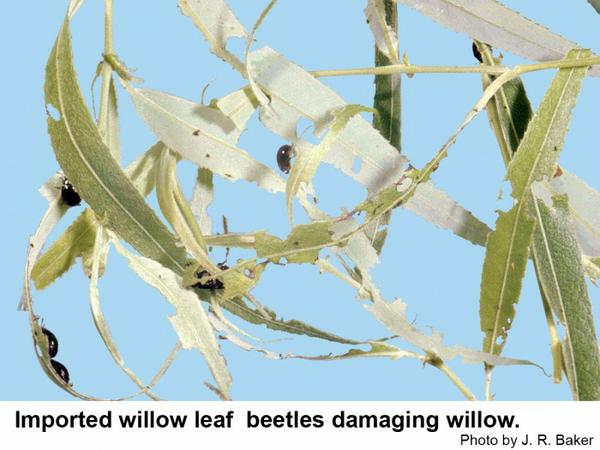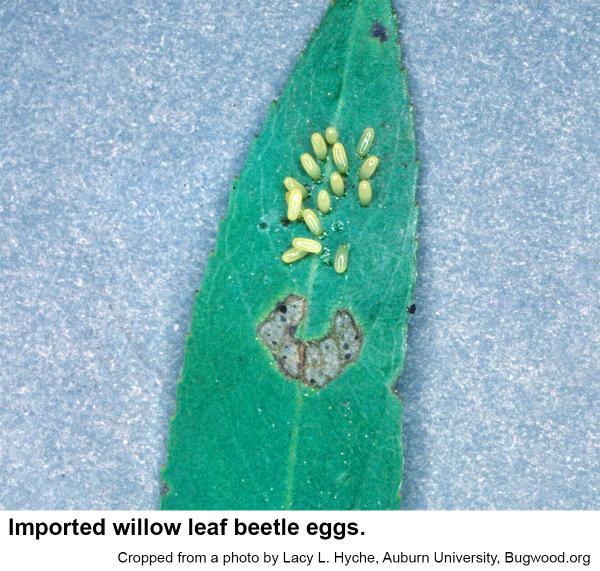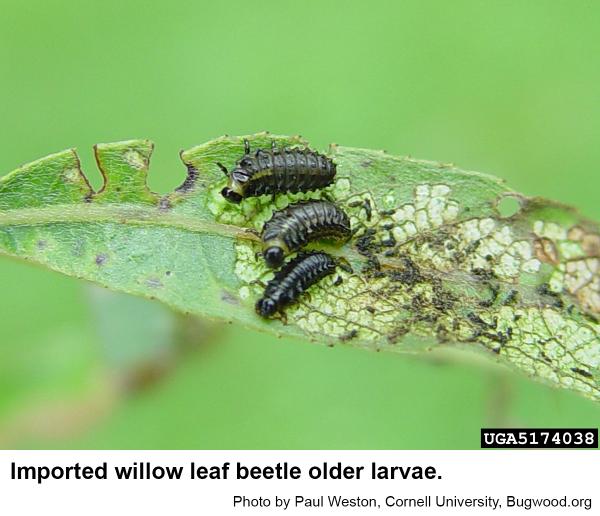Description and Biology
The imported willow leaf beetle, Plagiodera versicolor, resembles a black lady beetle. (Lady beetles are in a different family, and the black ones usually have orange spots of some sort.) Adult imported willow leaf beetles overwinter outdoors and emerge from their hibernation sites in spring. They feed for a while before females begin to lay eggs. Soon larvae hatch and all stages of the beetle can be found. Both stages feed on foliage of willows during the summer. At least two generations occur each year.
Host Plants
Imported willow leaf beetles attack the foliage of willows, cottonwood, and poplar (not tulip poplar). Adults notch and chew holes in the leaves, and their larvae skeletonize the leaves. From a distance, infested trees gradually turn off color and the tree may eventually appear to be dead. Although complete defoliation of a willow is not fatal, it's not good for it either!
Residential Recommendation
One reason the beetles seem to come back after treatment is that pesticides may not kill the eggs so that after treatment additional larvae hatch to carry on the family tradition. Another reason may be that the beetles do not all emerge from their hibernating quarters on the same day. Thus, the trees may be reinfested after the treatment. Mavrik, Merit, permethrin, pyrethrins, Sevin, and Talstar are all labeled for beetle control in the landscape. When used as directed, pyrethroids are very toxic to insects but are not particularly hazardous to humans and pets (other than fish-avoid using pyrethroids around pools, ponds, and streams).
References
- Biology and Management of Insect Pests in North American Intensively Managed Hardwood Forest Systems. Coyle, D. R. et al. 2005. Annual Rev. of Entomology 50: 1-29.
- Cycloalexy: A new concept in the larval defense of insects. Jolivet, P. et al. 1990. Insecta Mundi Vol. 4, No. 1-4.
- Imported Willow Leaf Beetle, Plagiodera versicolora (Laicharting); Family: Chrysomelidae. Klass, C., W. T. Johnson, and P. A. Weston. 2012 (update). Insect Diagnostic Lab. Cornell University, Dept. of Entomology.
- The biology of the imported willow leaf beetle, Pagiodera versicolora (Laicharting). Wake, M. J. 1994. Pages 541-547 In Novel Aspect of the Biology of Chrysomelidae. Jolivet, P. H., M. L. Cox and E. Petitpierre editors.
- Extension Plant Pathology Publications and Factsheets
- Horticultural Science Publications
- North Carolina Agricultural Chemicals Manual
For assistance with a specific problem, contact your local N.C. Cooperative Extension Center.
This Factsheet has not been peer reviewed.
Publication date: Nov. 28, 2012
Reviewed/Revised: May 4, 2023
Recommendations for the use of agricultural chemicals are included in this publication as a convenience to the reader. The use of brand names and any mention or listing of commercial products or services in this publication does not imply endorsement by NC State University or N.C. A&T State University nor discrimination against similar products or services not mentioned. Individuals who use agricultural chemicals are responsible for ensuring that the intended use complies with current regulations and conforms to the product label. Be sure to obtain current information about usage regulations and examine a current product label before applying any chemical. For assistance, contact your local N.C. Cooperative Extension county center.
N.C. Cooperative Extension prohibits discrimination and harassment regardless of age, color, disability, family and marital status, gender identity, national origin, political beliefs, race, religion, sex (including pregnancy), sexual orientation and veteran status.





